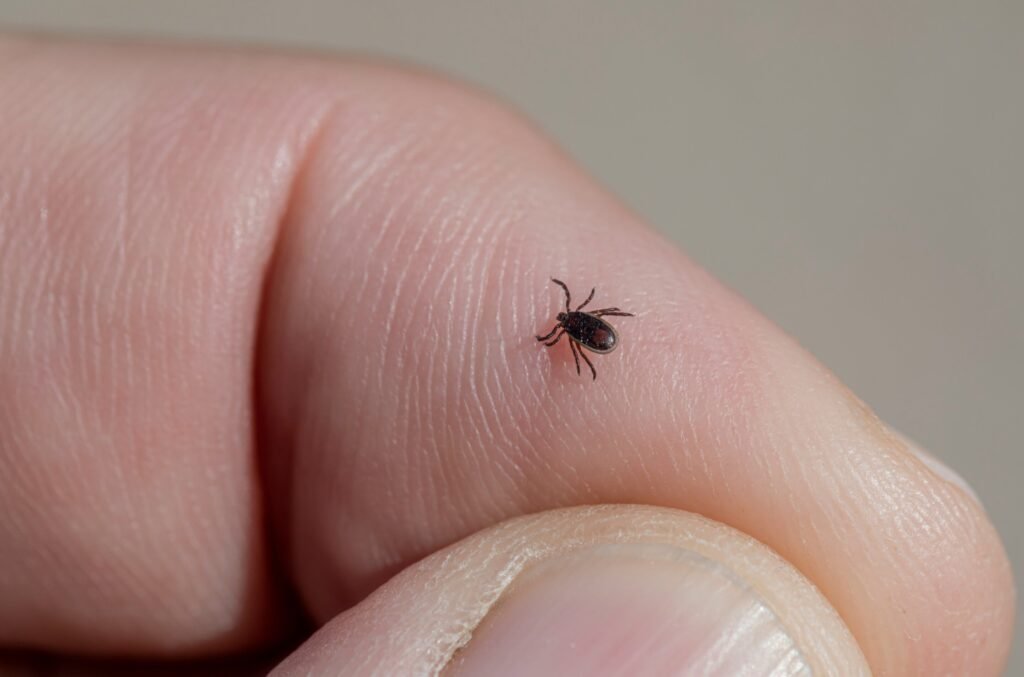It’s officially summer, a time for barbecues, the beach—and protecting yourself against the teeny, tiny black-legged deer ticks that cause most Lyme disease cases.
Nearly a half-million cases of Lyme disease are diagnosed and treated each year, and the majority of them are reported in June, July and August.
“This is when a lot of people get infected,” says Northeastern professor Kim Lewis, director of the university’s Antimicrobial Discovery Center.
Not only are people more likely to be outdoors during the summer months and encounter ticks, the ticks are in what is called their nymphal stage and are so small—the size of a poppy seed—they are hard to spot and remove.
Preventing bites is key to avoiding disease, according to experts at Northeastern University and the Centers for Disease Control and Prevention.
Here are five tips to keep ticks at bay and guarantee their quick removal if they end up on your clothes or skin.
Shower and check for ticks
Taking a shower within two hours after coming indoors can help wash unattached ticks off and prevent Lyme and other tick-borne diseases, the CDC says.
The federal agency says showering is also a good time to do a tick check.
Use a handheld or full-length mirror and take a good look at areas ticks are drawn to in particular: under the arms; in and around the ears; inside the belly button; in back of the knees; in and around hair on your head; between the legs; and around the waist.
Run your clothes through the dryer
“Ticks hate being really hot,” says Northeastern professor Constantin Takacs, who studies black-legged deer ticks in his lab.
He says putting clothes that you wore outdoors in the dryer will kill any ticks outright.
The CDC suggests tumbling clothes in a dryer on high heat for 10 minutes to kill ticks—longer if the clothes are damp.
Cold and medium temperatures will not kill ticks, the federal agency says. So if clothes require washing first, use hot water.
Treat clothes and gear with permethrin
Spraying clothing, camping tents and other gear with the insecticide permethrin has been shown to immobilize and kill ticks.
Treating socks and shoes is particularly effective. A study in Rhode Island showed that people who wore permethrin-treated footgear and socks were nearly 74% less likely to be bitten by a tick.
The federal agency provides a YouTube instructional video on spraying clothing with permethrin. People can also purchase pre-treated clothing, which, like home-treated clothing, should be laundered separately from non-treated items.
The CDC recommends using a product containing at least 0.5% permethrin and letting clothing dry before wearing. Never use permethrin on bare skin.
Tick and mosquito repellents such as DEET can be used on the skin as well as clothing. The Environmental Protection Agency offers a search tool to help people find the product that best meets their needs.
Protect your pets
Not only can pets get tickborne diseases, they can carry the ticks that transmit Lyme and other diseases into your home.
Consider getting a Lyme disease vaccine for your dog and talking to your veterinarian about the best tick prevention products for your pet.
The CDC says since cats are very sensitive to chemicals, never apply tick prevention products to your feline friends without first talking to a veterinarian.
And remember to check your dogs for ticks after they have been outside. Ticks especially like to attach in and around the ears, around the eyelids, under the collar, around the tail, between the back legs, under the front legs and between the toes, the CDC says.
Check your yard
The federal health agency says that since ticks flourish in grassy, brushy or wooded areas, mowing the lawn frequently and situating playground equipment, decks and patios away from yard edges and trees can minimize tick encounters.
The same goes for cutting tall grasses and brush at the edges of lawns and removing leaf litter.
If you choose to spray pesticides outdoors to control ticks, follow label instructions and check with local health or agricultural officials about the best products to use and best times to use them, according to the CDC, which says the Connecticut Agricultural Experiment Station has a comprehensive handbook on yard management.
This story is republished courtesy of Northeastern Global News news.northeastern.edu.
Citation:
How to prevent tick bites: Five expert tips for summer safety (2025, June 23)
retrieved 23 June 2025
from https://medicalxpress.com/news/2025-06-expert-summer-safety.html
This document is subject to copyright. Apart from any fair dealing for the purpose of private study or research, no
part may be reproduced without the written permission. The content is provided for information purposes only.


